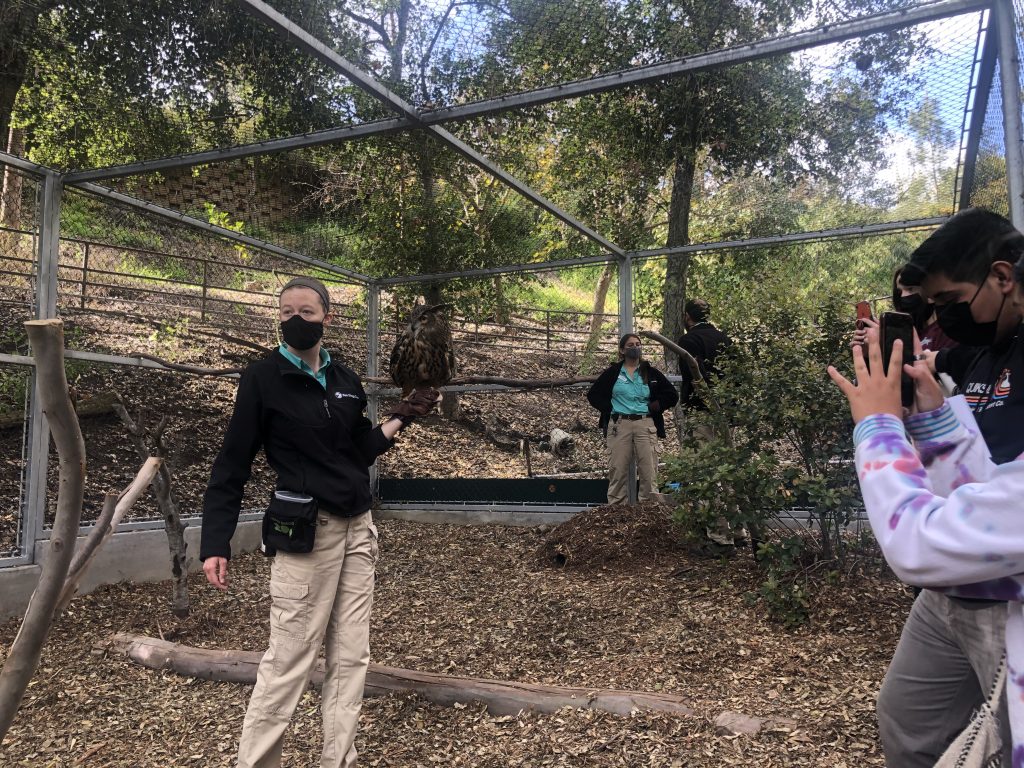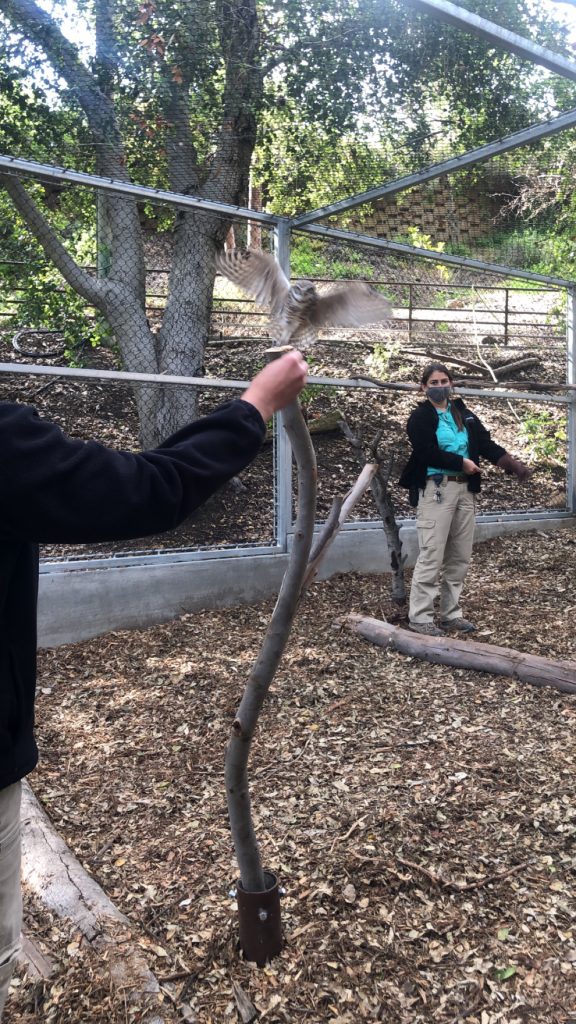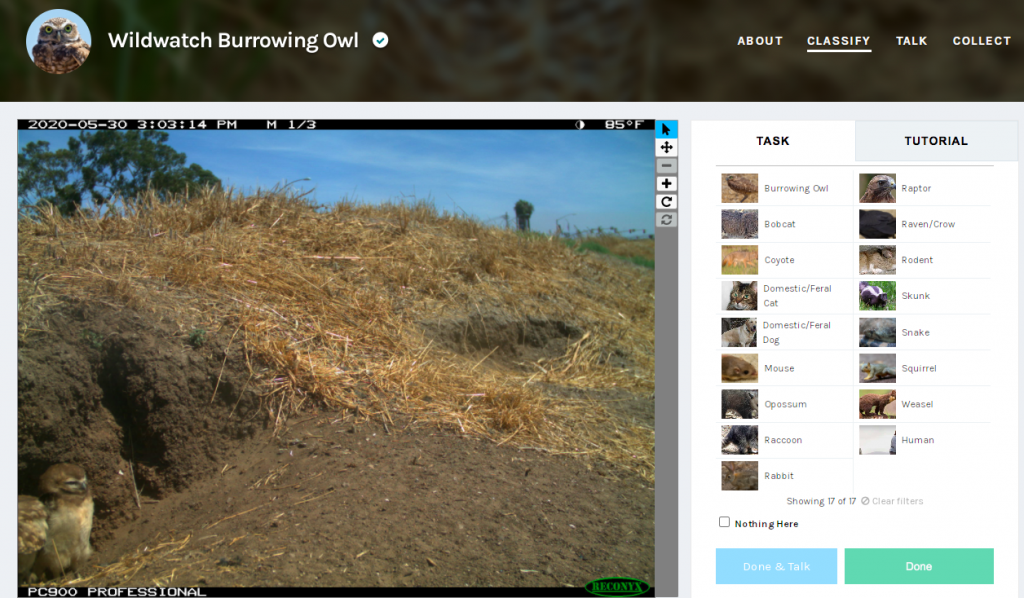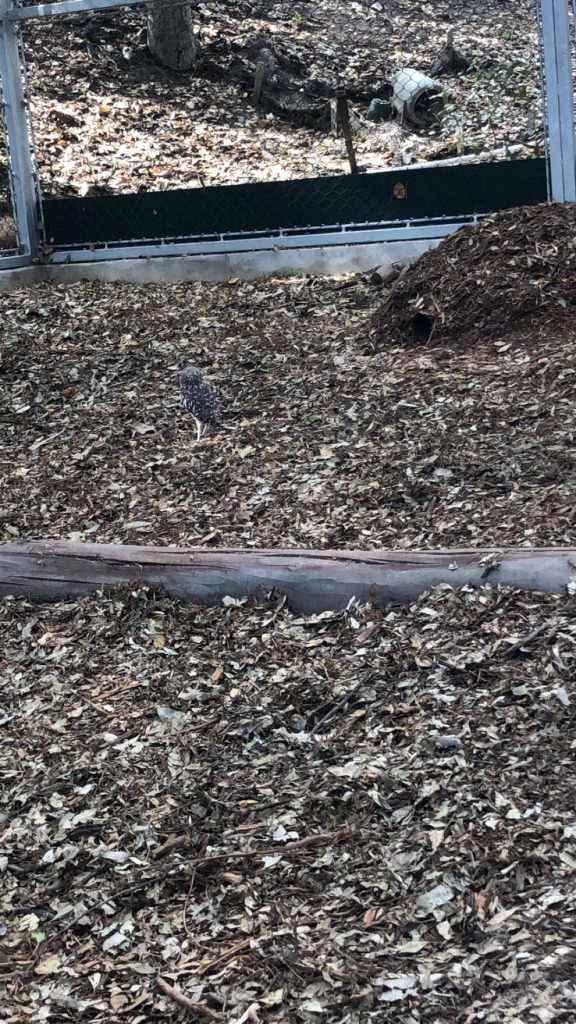Zoo InternQuest is a seven-week career exploration program for San Diego County high school juniors and seniors. Students have the unique opportunity to meet professionals working for the San Diego Zoo Wildlife Alliance, to learn about their jobs, and then blog about their experience online. Follow their adventures here on the Zoo’s website!
Did you know there is an owl that isn’t nocturnal and lives underground rather than in a tree? Enter the burrowing owl. This week the interns met the observant Buttonwillow, a burrowing owl. They then had the opportunity to meet Senior Research Coordinator Susanne Marczak. Ms. Marczak monitors and helps with the conservation of burrowing owl populations all over San Diego County. Some of her tasks include banding the owls and building artificial nests for them. Ms. Marczak’s job keeps her busy but she loves it nonetheless.

Before Susanne Marczak embarked on her journey as a Senior Research Coordinator at the Beckman Center for Conservation Research (BCCR), she asked the age-old question: “What do I want to do when I grow up?” After a bit of pondering, she went to UCLA with a vague idea of her interests and came out with an undergraduate degree in Ecology, Behavior, and Evolution with a double major in Economics. It was by chance that Ms. Marczak landed a job at the BCCR, thinking she’d only stay for a couple years, unaware that she was slowly but surely “being drawn into an ecological soap opera.” She recalls gradually manifesting her passion for the burrowing owl, growing a deeper and deeper appreciation for what she initially thought would be a short project with a couple of tiny birds. In fact, before becoming a professional burrowing owl lover, Marczak was unaware of the existence of these fascinating birds. She now works full time and spends 2-3 days a week in the field with a group of equally capable researchers, most of which hold master’s degrees and PhDs. Marczak spends her days witnessing and experiencing the “triumphs and struggles” of these owls, enjoying every last bit of it.

Ms. Marczak specializes in western burrowing owl conservation, focusing on population establishment, GPS satellite tracking, and breeding programs. As a field biologist, she also coordinates logistics and manages data. She has spent 10 years working for the San Diego Zoo Wildlife Alliance and although she is extremely passionate about her job, it isn’t without its obstacles such as a fluctuating work schedule that changes with the seasons and having projects that depend on grant funding. However, in her eyes, these obstacles are worth it because of her ever growing passion to help conserve a very unique species, burrowing owls! Ms. Marczak loves many aspects of her occupation; the job is very teamwork-oriented and she expressed that her colleagues are like family to her. Creative thinking is a major skill for her work and it is also amongst one of her favorite things. While conducting artificial burrow research, Ms. Marczak recollects that coming up with innovative solutions in her team of diversely experienced co-workers is one of the various perks of her job.

She states that most of the unforgettable memories in her field of work have been created in challenging situations. While transporting owls in the sweltering heat of Coachella Valley, she filled bags of dirt alongside her colleague. They both broke out in laughter after realizing the lengths they go to in order to care for these beloved burrowing owls. Furthermore, Ms. Marczak’s profession has brought her a sense of gratitude. She received one of her first jobs with the U.S. Geological Survey Agency, serving as a tracker for garter snakes in Northern California. She recalls quietly observing them in their natural habitat of both preserved wetland and agricultural land, while taking in the scenery and feeling a sense of appreciation to view a landscape that differs from her everyday sights.
Burrowing owls, a small species of owl that live in the ground, are some of the most unique owls out there. One of the things that makes them so different is their sleep schedule: burrowing owls are diurnal (awake during the day) or crepuscular (awake at dawn and dusk), a rarity as most owls are known for being nocturnal (awake at night). Being awake during the day helps protect them from predators–many of which are nocturnal–which means they can hunt in safety during the day. Another unique factor that sets them apart is their living environment: burrowing owls, as their name suggests, live in burrows made by other animals (squirrels, foxes, etc.), rather than in trees. They decorate the outside of their burrows with scat from nearby wildlife, which attracts both insects (one of their main sources of food) and mates. Additionally, burrowing owls are social and live in small family groups, usually consisting of the parents and their young (although after about a couple months, the young owls are ready to live on their own). Living in these social groups means that burrowing owls are very vocal; they use vocalizations not only to communicate and warn of any incoming dangers, but also to help defend themselves. They can mimic the sounds of certain larger and more dangerous animals, like rattlesnakes, which helps ward off predators that may be looking for an owl-sized snack. All of these features set these cute creatures apart and make them a fascinating animal worthy of admiration.


Burrowing owls’ conservation status varies depending on where you are in the world. In the United States there is a concern for their conservation, and in San Diego they are at risk of going locally extinct. Their main threat is human impact, which can range from vehicle collision, habitat loss, and the removal of fossorial mammals (who they depend on to dig their burrows). The good news, however, is that these owls can handle low to moderate levels of human disturbance, can reproduce fairly quickly, and artificial burrows can help their population rebound. Ms. Marczak and her team work to help the dwindling owl populations by breeding, releasing, and monitoring burrowing owls throughout San Diego County, including the regions of Jamul, Ramona, and Otay Mesa. They band small “name-tags” on each of the owls they release, which allows them to track individuals, understand population dynamics, and solve problems that may appear. Her team has also set up remote trail cameras to collect data. They were even able to notice a number of flea and parasitic outbreaks using these techniques, which helped them treat the owls. Her team has created artificial burrows in order to encourage the owls to breed. There are three pairs of burrowing owls at the San Diego Zoo Safari Park and their mating season lasts from February 1st to August 31st. These breeding pairs are helping repopulate burrowing owl populations locally, and if you would like to see an inside look at their lives you can watch them on the Burrowing Owl Camera. Another way to view these owls while aiding her research is by visiting Wildwatch Burrowing Owl, which allows you to help identify burrowing owls using trail cameras set up in their native habitat. Although there isn’t much you can do at the individual level to help preserve burrowing owl populations, Ms. Marczak advises that getting involved with local government and knowing what’s going on in your community can go a long way. At a local level, your voice and vote can help save these owls and their diminishing habitat.

Throughout her career, Ms. Marczak has gained a lot of experience and knowledge from years of dedicated work, which she was delighted to share with the interns. She stressed how vital it is to always be willing to learn from your peers and expand your own knowledge past what you learn in school. Sometimes the most important things to learn cannot be taught in a normal classroom environment. Skills such as collaboration and fieldwork can only be learned through experience. This ties into Ms. Marczak’s next piece of advice: take opportunities when they present themselves. Even if the topic doesn’t immediately jump out at you, it is important to explore new things to find what you are really passionate about. While it is important to put time and effort into learning and participating in different opportunities, you must not let it overtake your personal life. Ms. Marczak emphasized the value of finding a work-life balance, encouraging others to “be an advocate for yourself and what you want from your work and life.”

As the interns conversed with Ms. Marczak, her passion for her job was undeniably apparent. She described the joys of her career and explained how sometimes, you have to do unpleasant work in the name of doing what you love. She shared her experiences observing the small yet mighty burrowing owl. Ms. Marczack’s career has given her the opportunity to get a uniquely intimate view of the remarkable lives of burrowing owls from chick to adult. Through her work she has maintained burrowing owl populations with the help of her team. Her experiences are truly eye-opening and can hopefully inspire others to learn about how they can protect burrowing owls. All in all, conservation takes hard work, but researchers like Ms. Marczak are driven by their burning passion for wildlife.
Week Four, Spring Session 2021


